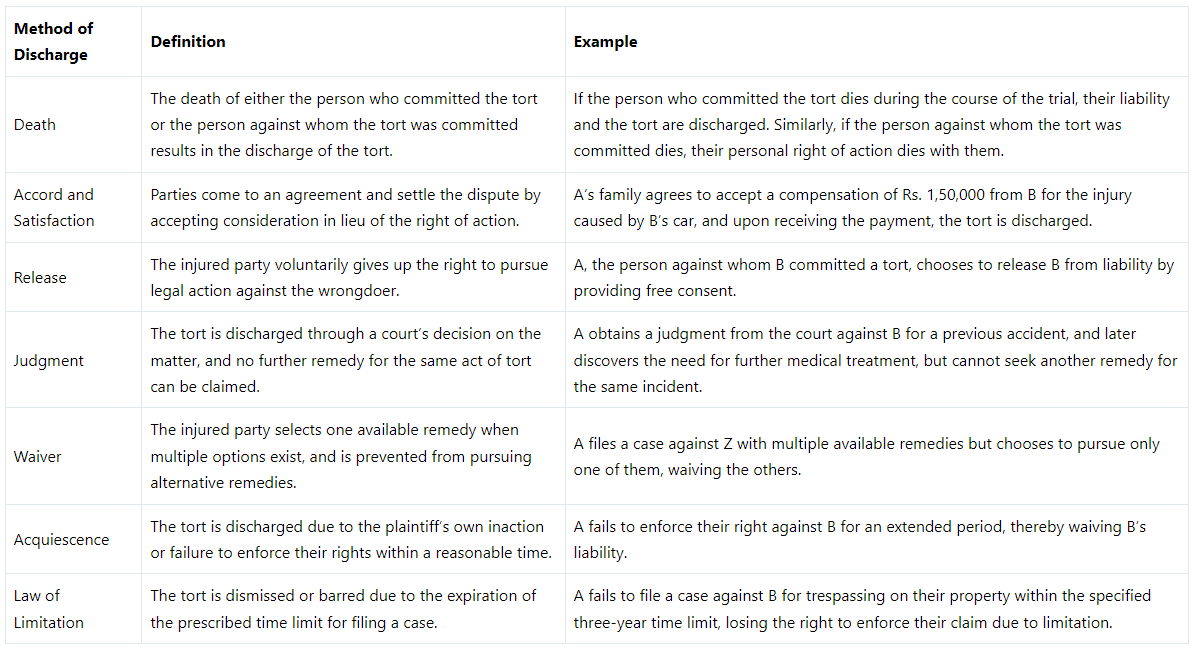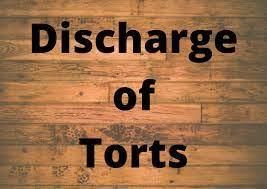Discharge of Torts | Civil Law for Judiciary Exams PDF Download
Discharge of Torts
Definition: The term "discharge of torts" refers to the termination or resolution of a tortious claim or legal action, signifying the extinguishment of legal liability associated with a tort.
The following are the modes of discharge of torts:
- Death of the parties
- Accord and satisfaction
- Release
- Judgment
- Law of limitation
- Waiver
- Acquiesce
These methods serve as ways to discharge torts and terminate the liability of the wrongdoer in tort law.

Understanding the Principle of 'Death of the Parties'
Definition: The legal maxim "actio personalis moritur cum persona" signifies that when an individual dies, their personal right of action also ceases to exist.
Application of the Maxim
- Death of the Plaintiff: When the individual against whom a tort is committed passes away, their right to seek damages or take legal action is extinguished.
- Example: If a person (A) initiates legal proceedings against another (B) for a tort but dies during the ongoing trial, the tort is discharged as the right of action is no longer valid.
- Exceptions for the Plaintiff: Laws like The Legal Representative Suits Act, 1885, allow the legal representative or executor of the deceased to continue legal proceedings on their behalf.
Death of the Defendant
If the person responsible for committing a tort dies, the tort is considered discharged.
Case Illustration: Prusti v. Mohanty: The High Court of Orissa ruled that liabilities from a money decree against an individual do not extend to the defendant’s son after the defendant's death.
Exceptions for the Defendant: Laws like The Legal Representative Suits Act, 1885, ensure that legal actions can be continued by the legal representative of the deceased defendant.
Accord and Satisfaction
- Accord and satisfaction involve an agreement between parties in a tort to resolve a dispute.
- An accord is the agreement itself, where one party agrees to provide something of value in exchange for settling the issue.
- Satisfaction refers to the actual fulfillment of the agreed-upon consideration by both parties involved.
- Once both accord and satisfaction are complete, the tort is considered resolved, and legal action ceases.
Illustration:
- For example, if A dies due to an injury caused by B, A's family might agree with B on a compensation amount of Rs. 1,50,000.
- Here, the accord is the agreement on the compensation, and the satisfaction is the actual payment of Rs. 1,50,000 by B to A's family.
- Accepting this payment forfeits A's family's right to pursue legal action, resolving the tort.
- The consent of all parties involved in accord and satisfaction must be given freely without coercion, fraud, or undue influence.
Illustration:
- For instance, if a wealthy individual coerces a servant into an agreement after assaulting them, the consent obtained is not considered free.
- In such a case, the accord and satisfaction would be invalid due to the presence of undue influence.
Release
- The concept of release in legal terms involves relinquishing the right to pursue legal action. It occurs when an individual voluntarily waives their claim for a tort, and this privilege is exclusive to the person against whom the offense was committed.
- Illustration:
- Situation 1: Suppose B commits a wrongful act against A. If A willingly decides to release B from any liability arising from the act, they have the legal option to do so.
- Situation 2: In a scenario where both B and C are involved in wrongful acts against A, if A chooses to release B from liability, it does not absolve C of their responsibilities.
- A release must be voluntary and based on the uninfluenced consent of the injured party. If consent is obtained through coercion, undue influence, or any other illegitimate means, such a release is deemed invalid, and the tort remains unresolved.
- Illustration:
- For example, if a police inspector, abusing their authority and using intimidation tactics, coerces the injured party into releasing them from liability, that release is not legally binding.
Judgement
- In this method, the resolution of a tort happens through a court judgment. Once a court makes a decision on a matter, the tort is considered resolved, and there can be no further appeal in a court of law for the same issue.
- This method is based on the legal concept of Res Judicata, which essentially means that if a court has already made a decision on a particular matter, the same matter cannot be brought up again in court.
Illustration: If, for example, A sues B for damages resulting from an accident and the court rules in favor of A, providing a remedy, if A later realizes they need additional medical treatment related to the same accident, they cannot file another lawsuit seeking more compensation.
Case Example (Fitter v. Veal): In this historical case, the plaintiff sued the defendant for assault and received a remedy determined by the court. Later, when the plaintiff needed further medical assistance, they attempted to seek additional compensation for the same assault. The court rejected this plea, citing that once a judgment is made, no further appeal can be made regarding the same tort.
Exceptions
There are exceptions to the general rule of judgment serving as a discharge of tort.
- Exception 1: If the lawsuit involves the same parties but pertains to a different remedy or addresses a violation of a separate right, the court may consider the new petition.
Case Example (Brunsden v. Humphrey): For instance, a cab driver who has already been compensated for damage to their vehicle may later realize they suffered a hand fracture due to the same accident. In such a scenario, they can seek a remedy for the injury to their person. - Exception 2: If the individual who was previously held responsible for the tort commits the same act again, it is seen as a fresh case and can be pursued.
Illustration: If person A trespasses against person B and is found liable by the court, if A repeats the same offense against B and argues against being penalized twice for the same offense, this defense is not valid as it constitutes a separate case.
Understanding Waiver in Tort Law
- The concept of waiver serves as a method of discharging a tort, where an individual must make a choice between available remedies, selecting only one.
- It is crucial to note that pursuing multiple remedies simultaneously is generally not permissible, with exceptions existing in cases involving defamation and assault.
Key Principles of Waiver
- When opting for a remedy, the individual must commit to their choice. If the chosen remedy proves unsuccessful, they are typically not allowed to switch to an alternative.
- For instance, if someone initiates legal action with multiple available remedies and the chosen one does not succeed, they are usually bound to that decision without the option to switch.
- Waiver can manifest in two forms: expressed or implied.
- Express waiver involves the explicit communication of the individual's choice within a legal setting.
- For example, in a scenario where legal remedies exist in both contract and tort law, the individual must clearly indicate their selection to the court.
- On the other hand, implied waiver is deduced from the person's actions or behavior.
- Consider a situation where an individual has the option to pursue remedies under both contract and tort law. If they decide to proceed with the contract remedy, their choice is implied through their actions.
By understanding the principles of waiver in tort law, individuals can navigate legal scenarios effectively, making informed decisions regarding available remedies.
Acquiescence
- Definition: Acquiescence refers to a situation where a tort claim is discharged due to the plaintiff's own inability or incapacity to enforce their rights within a reasonable time frame.
- Explanation: When a person entitled to enforce their legal rights against another party fails to do so for an extended period, it implies a voluntary waiver of the other party's liability.
- Example: For instance, if individual A has the legal right to pursue a claim against individual B but does not take action within a significant period, it results in a scenario where B is considered released from their liability towards A.
Law of Limitation
- Definition of Law of Limitation: The Law of Limitation dictates that a tort is discharged when the specified time limit for filing a case expires. Once this time limit passes, individuals lose the right to enforce their claims.
- Time Limits for Filing Cases:
- For instances like false imprisonment or libel, the time limit for filing a case is typically one year.
- In cases of trespass to immovable property, the limit extends to three years.
- Illustrative Example:
- If B commits a trespassing tort on A's property and A neglects to initiate legal proceedings within three years, A forfeits the right to seek legal recourse due to the limitation period.
Consequences of Discharge of Torts
- Termination of Legal Liability: When a tort is discharged, it means that the legal responsibility for the wrongful act is ended. The party who committed the tort is no longer held accountable for their actions, and the injured party loses the right to seek further remedies or damages.
- Closure and Finality: Discharging a tort brings closure to legal disputes, allowing the parties involved to move on from the incident and avoid prolonged legal battles. It promotes finality, resolving the matter so that parties can focus on other aspects of their lives.
- Preservation of Judicial Resources: By discharging a tort, the legal system is relieved of the burden of ongoing litigation. This enables courts to allocate their resources to other cases and prioritize new disputes, ensuring the efficient functioning of the legal system.
- Limitation of Remedies: After a tort is discharged, the injured party loses the right to seek additional remedies. This limitation prevents continuous legal actions against the wrongdoer, emphasizing finality in legal proceedings.
- Impact on Precedent: Discharging a tort can influence legal precedent, shaping how the law is interpreted and applied in future cases. Court decisions related to discharged torts establish consistent legal principles and guide legal professionals.
- Deterrence and Compliance: The discharge of torts can act as a deterrent, encouraging individuals to follow legal norms and avoid wrongful behavior. Knowing that liability can be discharged incentivizes compliance with the law and avoidance of legal consequences.
- Protection of Rights: Discharge of a tort ensures that the legal rights and obligations of both parties are upheld. It emphasizes fairness, justice, and the rule of law, acknowledging that appropriate remedies have been sought and the rights of both parties have been considered.
Conclusion
- Discharge of torts can occur through various means such as the death of the parties, accord and satisfaction, release, judgment, waiver, acquiescence, and the law of limitation.
- When a tort is discharged, it results in the legal liability coming to an end, closure and finality of the legal dispute, preservation of judicial resources, limitation of remedies, impact on legal precedent, deterrence and compliance, and the protection of rights.
|
363 docs|256 tests
|
FAQs on Discharge of Torts - Civil Law for Judiciary Exams
| 1. What is the principle of 'Death of the Parties' in the context of discharge of torts? |  |
| 2. What is the significance of Accord and Satisfaction in discharging torts? |  |
| 3. How does the law of limitation impact the discharge of torts? |  |
| 4. What is the role of waiver in tort law and how does it impact the discharge of torts? |  |
| 5. How does acquiescence affect the discharge of torts? |  |
















